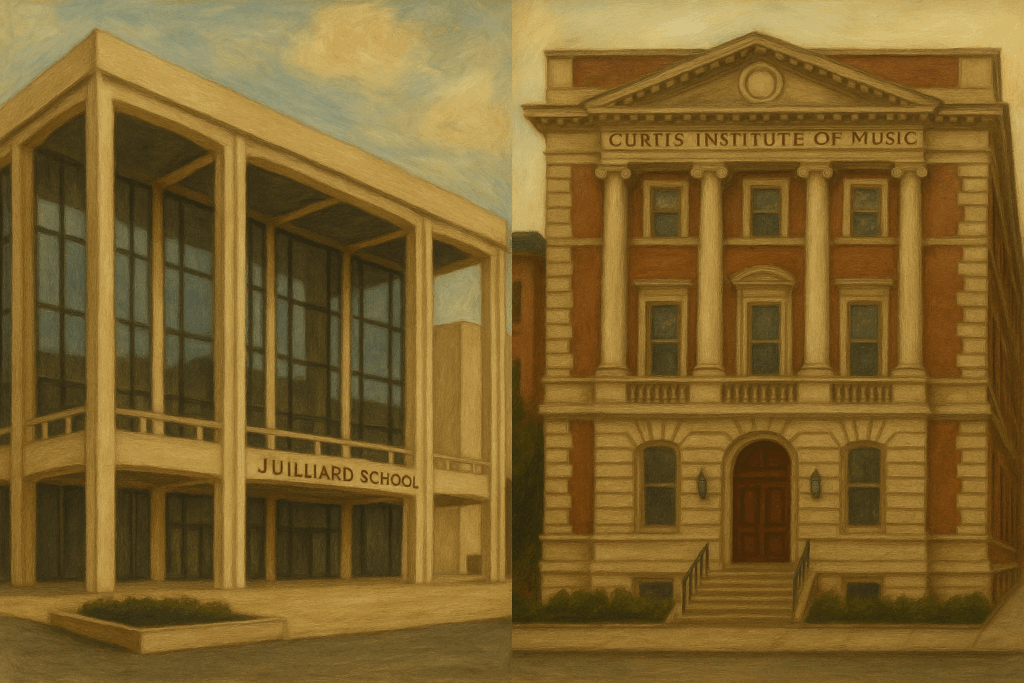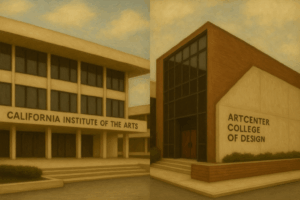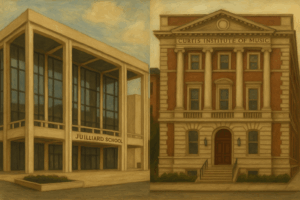
The GOAT of American Music Conservatories?
For young artists dreaming of the pinnacle of world classical music, The Juilliard School and The Curtis Institute of Music signify more than just schools. These two institutions represent two fundamentally different philosophies for nurturing artistic genius. Therefore, the choice between them is not a matter of ‘which is better,’ but rather a question that demands deep introspection: ‘Which environment resonates with my artistic DNA?’
This article, based on the latest 2025 information, provides an in-depth comparison of Juilliard, which functions like a crucible of comprehensive arts in the heart of the world’s cultural capital, New York, and Curtis, which operates like a small, elite family of musicians in the historic center of Philadelphia. This will be a precise map to gauge whether the artist you dream of becoming lies within Juilliard’s vast spectrum or Curtis’s concentrated depth.
1. Founding Ideals and History: Different Beginnings, Same Goal
Juilliard: Dreaming of the Heart of American Arts
Juilliard’s origins trace back to the dream of Frank Damrosch in 1905, who sought to establish a music conservatory where talented American musicians could receive the highest level of education in their own country without having to study in Europe. It later expanded into a comprehensive arts institution by adding dance and drama divisions, and in 1969, it moved to New York’s Lincoln Center, solidifying its position as a center of world culture. The history of Juilliard is a grand narrative that parallels America’s growth into the cultural center of the world.
Curtis: A Generous Investment in Talent
The birth of Curtis began in 1924 with the altruistic conviction of Mary Louise Curtis Bok, a publishing heiress. She dreamed of a conservatory where the most promising young musicians could hone their talents without economic barriers.
This dream was realized by the ‘tuition-free’ policy established in 1928. This single decision became the ‘source code’ that defines everything about Curtis today. Curtis selects the world’s most talented students based solely on “artistic promise,” which naturally maintains an extremely small student body.
2. Educational Philosophy and Curriculum: Two Ways to Make an Artist
Juilliard: The Crucible of Comprehensive Arts
Juilliard’s educational philosophy can be summarized by ‘comprehensiveness’ and ‘intellectual depth.’
- Scope of Education: It offers a vast spectrum of degree programs centered around the three main pillars of music, dance, and drama, including jazz and historical performance.
- Intellectual Depth: All students are required to take a broad range of liberal arts courses alongside core subjects like music theory and music history. Cross-registration with Columbia University is also available.
- Direction in 2025: It is evolving into a ‘foundry’ that nurtures ‘artist-citizens’ equipped with social responsibility and self-sufficiency beyond technical perfection, with ‘Equity, Diversity, Inclusion, and Belonging (EDIB)’ and ‘Creative Enterprise’ as core values.
Curtis: The Cradle of Performance-Ready, Elite Musicians
Curtis’s educational philosophy is condensed into two words: ‘focus’ and ‘practice.’
- Scope of Education: It concentrates all its resources solely on training classical music performers.
- Core of Education: The philosophy of ‘learn by doing.’ This means that performance is not just the result of education, but the educational process itself.
- Direction in 2025: It is integrating the old-world spirit of craftsmanship with new-world career realities by offering practical skills like social entrepreneurship, pedagogy, and digital media through its ‘Career Studies’ and ‘Artist-Citizen Curriculum.’
3. Faculty and Performance Opportunities: Where Dreams Become Reality
Juilliard: A Convergence of World-Renowned Prestige
Juilliard’s faculty is truly an ‘all-star team.’ It is composed of global icons whose names are brands in themselves, such as Hilary Hahn, Midori, Itzhak Perlman, and Yoheved Kaplinsky. Juilliard hosts an overwhelming number of over 700 performances annually, making world-class stages like Carnegie Hall a routine part of a student’s experience.
Curtis: An Intimate Apprenticeship with Active Artists
A significant portion of Curtis’s faculty is composed of active performers, including principal players from The Philadelphia Orchestra. Additionally, through a strong tradition of hiring distinguished alumni as faculty, the unique ‘Curtis Sound’ and educational philosophy are passed down in an apprenticeship style. The ‘Curtis on Tour’ program offers a unique opportunity for students to perform as professional touring musicians around the world alongside faculty and alumni.
4. Alumni Who Became Legends: 20 Artists Who Changed the World
10 Masters Produced by Juilliard
- Yo-Yo Ma
A 19-time Grammy winner and Presidential Medal of Freedom recipient. This cellist redefined the role of a classical performer into a global cultural ambassador and is an icon of cross-genre and cross-cultural collaboration. - Itzhak Perlman
A 16-time Grammy-winning violinist, one of the greatest virtuosos of our time. Also famous for performing the theme of the film ‘Schindler’s List,’ he is a cultural symbol representing artists with disabilities. - John Williams
The living legend who created and defined the sound of modern film music, composing scores for ‘Star Wars,’ ‘Jaws,’ and more. A five-time Academy Award winner. - Miles Davis
The creator of cool jazz, modal jazz, and jazz fusion. One of the most influential musicians of the 20th century who changed the course of jazz history multiple times. - Renée Fleming
The quintessential soprano of the Metropolitan Opera. A five-time Grammy winner, she has led the opera stage with her elegant voice and intellect. - Wynton Marsalis
A Pulitzer Prize-winning trumpeter who straddles the worlds of classical and jazz. As the artistic director of Jazz at Lincoln Center, he is dedicated to preserving and educating the tradition of jazz. - Philip Glass
A pioneer of minimalist music. The most original and influential voice who changed the course of late 20th-century contemporary music. - Nina Simone
‘The High Priestess of Soul.’ A great artist who became the voice of the Black Civil Rights Movement, crossing genres of jazz, blues, and classical music. - Sarah Chang
A violinist who debuted as a child prodigy and grew into a world-class soloist. A star who continues the lineage of virtuoso performers. - Leontyne Price
The first African American superstar of the Metropolitan Opera. A pioneer who broke down racial barriers to stand at the top of the opera world.
10 Masters Produced by Curtis
- Leonard Bernstein
Composer of ‘West Side Story’ and music director of the New York Philharmonic. An all-encompassing maestro who established the identity of 20th-century American music as a conductor, composer, pianist, and educator. - Samuel Barber
Famous for his ‘Adagio for Strings,’ a leading neoclassical composer of 20th-century America. - Lang Lang
A pianist who became a global superstar with his dazzling showmanship and virtuosity. He has greatly contributed to the popularization of classical music. - Yuja Wang
A new icon of modern pianism, famous for her overwhelming technique and charismatic stage presence. - Hilary Hahn
A three-time Grammy winner. An innovator who has redefined the role of a modern violin soloist through her flawless technique, dedication to contemporary music, and communication via social media. - Jennifer Higdon
A Pulitzer Prize and three-time Grammy Award winner. Currently one of the most frequently performed American composers. - Nino Rota
The master who composed the music for the film ‘The Godfather.’ He successfully integrated classical composition techniques into film scoring. - Gian Carlo Menotti
A composer who made opera accessible to the American public, a two-time Pulitzer Prize winner, and the founder of the Spoleto Festival. - Anna Moffo
‘La Bellissima.’ A soprano who graced the stages of the Metropolitan Opera and La Scala in the 1960s. - Juan Diego Flórez
The leading bel canto tenor of our time. Famous for his phenomenal high notes and brilliant coloratura.
Conclusion: Which School Fits Your Musical DNA?
- Juilliard: The ‘Metropolis’ of the Arts
Juilliard is a vast metropolis of the arts. It’s a place where music, dance, and drama come together to inspire one another, and where the entire city of New York becomes the campus. It provides the optimal environment for the ‘comprehensive artist’ who seeks to cross various genres and expand their boundaries through collaboration with other artists. - Curtis: The ‘Sanctuary’ of Music
Curtis is a deep and pure sanctuary of music. It is a place where everything is focused on the perfection of classical music, where the teachings of masters are passed down through generations like a bloodline. It offers an unparalleled environment for the ‘artisan-like’ artist who pursues unerring precision and depth to reach the pinnacle of a single field.
In the end, the world needs both the versatile ‘artist-citizens’ nurtured by Juilliard and the perfected ‘masters’ forged by Curtis. Choosing between the two schools will be the most sincere answer to the question of what kind of artist you want to be in the world.


